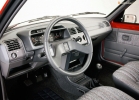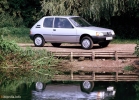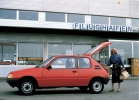technical characteristics of Peugeot 205 3 doors 1984 - 1998 hatchback
Technical characteristics of Peugeot 205 1993, 1994, 1995, 1996, 1997, 1998: power, fuel consumption per 100 km, weight (mass), road clearance (clearance), radius of the turn, type of transmission and brakes, body size and tires
Engine characteristics
| Modifications |
Engine volume, cm3 |
Power, kW (lp)/about |
Cylinders |
Twisting, Nm/(rpm) |
Type of the fuel system |
Type of fuel |
| 1.8 d |
1769 |
44(60)/4600 |
L4 (in -line location) |
110/2000 |
Indirect injection |
Diesel |
| 1.8 TD |
1769 |
57(78)/4300 |
L4 (in -line location) |
157/2100 |
Indirect injection |
Diesel |
| 1 |
954 |
33(45)/5200 |
L4 (in -line location) |
73/2400 |
Carburetor |
Petrol |
| 1.1 |
1124 |
40(54)/5800 |
L4 (in -line location) |
88/3200 |
Carburetor |
Petrol |
| 1.1i |
1124 |
44(60)/6200 |
L4 (in -line location) |
88/3800 |
Central injection (monovxing) |
Petrol |
| 1.4 (60 hp) |
1360 |
44(60)/5000 |
L4 (in -line location) |
105/2500 |
Carburetor |
Petrol |
| 1.4 (80 hp) |
1360 |
59(80)/5800 |
L4 (in -line location) |
109/2800 |
Carburetor |
Petrol |
| 1.4i |
1360 |
55(75)/6200 |
L4 (in -line location) |
109/4000 |
Central injection (monovxing) |
Petrol |
| 1.6i |
1580 |
66(90)/6400 |
L4 (in -line location) |
128/3000 |
Central injection (monovxing) |
Petrol |
Drive and transmission
| Modifications |
type of drive |
Type of transmission (basic) |
Type of transmission (optionally) |
| 1.8 d |
Front-wheel drive |
5-MKPP |
|
| 1.8 TD |
Front-wheel drive |
5-MKPP |
|
| 1 |
Front-wheel drive |
4-MKPP |
|
| 1.1 |
Front-wheel drive |
4-MKPP |
|
| 1.1i |
Front-wheel drive |
5-MKPP |
|
| 1.4 (60 hp) |
Front-wheel drive |
5-MKPP |
|
| 1.4 (80 hp) |
Front-wheel drive |
5-MKPP |
|
| 1.4i |
Front-wheel drive |
5-MKPP |
|
| 1.6i |
Front-wheel drive |
5-MKPP |
4-ACPP, |
Brake system and steering wheel amplifier
| Modifications |
Type of front brakes |
Type of rear brakes |
Power steering |
| 1.8 d |
Disk |
Drum |
no |
| 1.8 TD |
Disk |
Drum |
there is |
| 1 |
Disk |
Drum |
no |
| 1.1 |
Disk |
Drum |
no |
| 1.1i |
Disk |
Drum |
no |
| 1.4 (60 hp) |
Disk |
Drum |
no |
| 1.4 (80 hp) |
Disk |
Drum |
no |
| 1.4i |
Disk |
Drum |
no |
| 1.6i |
Disk |
Drum |
there is |
The size of the tires
| Modifications |
The size |
| 1.8 d |
155/70SR13 |
| 1.8 TD |
165/70SR13 |
| 1 |
135SR13 |
| 1.1 |
145SR13 |
| 1.1i |
145SR13 |
| 1.4 (60 hp) |
165/70SR13 |
| 1.4 (80 hp) |
165/70TR13 |
| 1.4i |
165/70TR13 |
| 1.6i |
165/70TR13 |
Dimensions
| Modifications |
Length, mm |
Width, mm |
Height, mm |
The track front/back, mm |
Wheel base, mm |
Road clearance (clearance), mm |
Trunk volume, l |
| 1.8 d |
3701 |
1560 |
1379 |
1349/1300 |
2421 |
140 |
215 |
| 1.8 TD |
3701 |
1560 |
1379 |
1349/1300 |
2421 |
140 |
215 |
| 1 |
3701 |
1560 |
1379 |
1349/1300 |
2421 |
140 |
215 |
| 1.1 |
3701 |
1560 |
1379 |
1349/1300 |
2421 |
140 |
215 |
| 1.1i |
3701 |
1560 |
1379 |
1349/1300 |
2421 |
140 |
215 |
| 1.4 (60 hp) |
3701 |
1560 |
1379 |
1349/1300 |
2421 |
140 |
215 |
| 1.4 (80 hp) |
3701 |
1560 |
1379 |
1349/1300 |
2421 |
140 |
215 |
| 1.4i |
3701 |
1560 |
1379 |
1349/1300 |
2421 |
140 |
215 |
| 1.6i |
3701 |
1560 |
1379 |
1349/1300 |
2421 |
140 |
215 |
Car weight
| Modifications |
Equipped mass, kg |
Maximum mass, kg |
Lifting capacity, kg |
| 1.8 d |
846 |
1300 |
454 |
| 1.8 TD |
865 |
1325 |
460 |
| 1 |
740 |
1160 |
420 |
| 1.1 |
745 |
1195 |
450 |
| 1.1i |
780 |
1220 |
440 |
| 1.4 (60 hp) |
770 |
1220 |
450 |
| 1.4 (80 hp) |
770 |
1220 |
450 |
| 1.4i |
810 |
1275 |
465 |
| 1.6i |
880 |
1300 |
420 |
Dynamics
| Modifications |
Maximum speed, km/h |
Acceleration time to 100 km/h, with |
CD (frontal resistance coefficient) |
| 1.8 d |
156 |
15.1 |
0.34 |
| 1.8 TD |
175 |
12.2 |
0.34 |
| 1 |
143 |
18.8 |
0.34 |
| 1.1 |
154 |
14.6 |
0.34 |
| 1.1i |
164 |
13.9 |
0.34 |
| 1.4 (60 hp) |
156 |
14.8 |
0.34 |
| 1.4 (80 hp) |
171 |
11.6 |
0.34 |
| 1.4i |
175 |
10.6 |
0.34 |
| 1.6i |
167 |
14 |
0.34 |
Test drives
Eight in a row
A car brand, indicated by the name of the designer or owner of the company, is a tribute to tradition and, in addition, a method that allows the latter to remain in the memory of descendants forever. In this way, they perpetuated their names Ford, Porsche, Ferrari ... The degree of perpetuation directly depends on the success of the company. And, as a result, the names of the losers and, accordingly, these brands are usually quickly forgotten after ...






